 |
  |
Archive CNES des données POLDER
The Advanced Earth Observing Satellite-II (ADEOS-II), the successor to ADEOS, has been developed to advance Earth observation technologies. It acquires data to help researchers understand the mechanism of the global environmental changes such as global warming and to support meteorology and fishery activities. It is equipped with two JAXA sensors :
- AMSR for quantitatively observing various geophysical data concerning the water cycle,
- and GLI for observing oceans, land and clouds with high accuracy.
It also carries three sensors provided by international and domestic partners :
- Improved Limb Atmospheric Spectrometer - II (ILAS-II) to monitor the high-latitude stratospheric ozone,
- SeaWinds Scatterometer for high accuracy wind speed and direction measurements,
- Polarization and Directionality of the Earth's Reflectances (POLDER) to observe the polarization, directional and spectral characteristics of solar light reflected by aerosols, clouds, oceans and land surfaces.
Scientific objectives
ADEOS-II is expected to provide the data necessary for us to understand the circulation of water, energy, and carbon in order to contribute to studies on global environmental changes.
The scientific goals of ADEOS-II can be summarized as follows :
- Regularly monitor the water and energy cycle as a part of the global climate system.
- Quantitatively estimate the biomass and fundamental productivity as a part of the carbon cycle, which plays an important role in global warming.
- Detect trends in long term climate change as a result of continuing the observations started by ADEOS.
Of these three points, monitoring the water and energy cycle is the most important one for the ADEOS-II mission.
- water-related parameters such as water vapor, precipitation, soil moisture, and snow depth retrieved from AMSR data
- cloud related parameters, water vapor, and aerosol estimated from GLI data
- sea surface stress parameters derived from SeaWinds data
- aerosol estimation from POLDER data
- and the ozone distribution estimated from ILAS-II data will be of great use in achieving this goal.
SeaWinds data, which continues the observation of sea surface stress by NSCAT on ADEOS, will help us understand the ocean tidal cycling, as well.
 Global SST distribution observed by AMSR |
 GLI chlorophyll-a concentration of seas around Japan |
Estimating the fundamental productivity and chlorophyll, as a part of the carbon cycle, is another important goal for ADEOS-II. Multi-channel observation and 250-meter resolution data of GLI will contribute significantly to achieving this goal.
In addition, ILAS-II data, which continues observation of ozone and minor species by ILAS on ADEOS, will help us understand the stratospheric chemistry as well.
POLDER/ADEOS-2 External Links: POLDER-1 and POLDER-2
